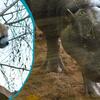The Queen’s Green Canopy (QGC) is a unique tree planting initiative created to mark Her Majesty’s Platinum Jubilee later this year. The initiative encourages both people and organisations across the United Kingdom to plant a tree for the Jubilee and Paignton Zoo are delighted to be involved.
The Devon based zoo planted 29 trees on the 10th February and invited representatives from all of their teams to take part and plant a tree. The purpose was to promote the importance of planting sustainably as well as to create a legacy to honour the Queen’s leadership of the nation spanning 70 years. After the disruptions and uncertainty of the pandemic, the zoo also believes that the planting represents something symbolic; putting down meaningful roots for the future of the zoo, and acknowledging the incredible efforts that staff have made in these challenging times.
“Today’s tree planting provides an opportunity for the Wild Planet Trust to humbly and with gratitude honour Her Majesty’s extraordinary service. The trees will provide a canopy under which future generations can enjoy nature and in which native species can thrive,” said Dennis Flynn, Chief Executive Officer of Wild Planet Trust, the charity that runs Paignton Zoo.
The zoo, which is recognised as a botanical garden as well as a zoological park, already has an established mix of trees across its 80 acre site, and these will complement their existing collection, as well as celebrate the monarch in a unique and sustainable way.
Catherine Mortimer, Deputy Curator of Botanics at Paignton Zoo said “The trees will serve as a visual token of our appreciation for the Queen and will also create new habitats for our native species including birds, bees and insects. What better way to honour the Queen’s legacy than to help provide a better future for our local wildlife.”
She continued “We have chosen a variety of trees including Whitebeam, wild cherry, and lime. Many of the trees we have selected are quick growing trees, some provide red fruits and some beautiful blossom, such as cherry. Hopefully they will delight our visitors with their rich colours and potential to provide both shelter and shade for years to come.”
Related Members
-
News
 Belfast Zoo helps to bring Christmas joy to Children’s Hospital 19th December, 2025Belfast Zoo joined the Lord Mayor of Belfast, Councillor Tracy Kelly, on Monday (15th December) to help bring festive cheer to the Royal Belfast Hospital…
Belfast Zoo helps to bring Christmas joy to Children’s Hospital 19th December, 2025Belfast Zoo joined the Lord Mayor of Belfast, Councillor Tracy Kelly, on Monday (15th December) to help bring festive cheer to the Royal Belfast Hospital… -
News
 Colchester Zoological Society welcomes new arrivals 19th December, 2025This December, Colchester Zoological Society (CZS) welcomed some exciting new arrivals! A young male pygmy hippo, Mikolas, from Zoo Dvur Kralove…
Colchester Zoological Society welcomes new arrivals 19th December, 2025This December, Colchester Zoological Society (CZS) welcomed some exciting new arrivals! A young male pygmy hippo, Mikolas, from Zoo Dvur Kralove… -
News
.png?w=100&h=100&zc=1&f=jpeg&hash=8d175f93cde920c5ba23c8ea7f92e55a) Blog: Understanding the human side of zoos 16th December, 2025Why are zoo researchers increasingly looking to social science? Dr Nieky van Veggel explains the significance of understanding the human dimension…
Blog: Understanding the human side of zoos 16th December, 2025Why are zoo researchers increasingly looking to social science? Dr Nieky van Veggel explains the significance of understanding the human dimension…



